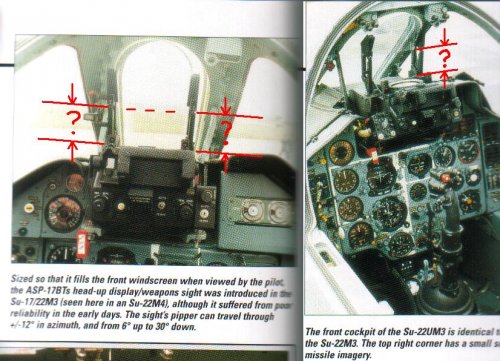An old question, but repeated somewhat more clearly now with some photos from Alexander Mladenov's article on Su-22 in IAPR #18:
How does it work? Can we really believe the ASP-17 gunsight pipper can aim "30 degrees down," when no portion of the gunsight combiner glass seems to extend below the horizon at all? Why does the text say the gunsight "fills the front windscreen," when in fact it seems to leave an elephant-sized gap at the bottom? Isn't that where ALL bullets, bombs, rockets and missiles should go? Who cares about filling the TOP of the windscreen (which the ASP-17 seems admirably well-shaped to do)? How does this thing aim at all? And if it works, then why do modern HUDs need to extend all the way to the bottom of the windscreen to accomplish the same bombing tasks? ???
Sincere questions - no slam against Sukhoi intended.
Yet.
How does it work? Can we really believe the ASP-17 gunsight pipper can aim "30 degrees down," when no portion of the gunsight combiner glass seems to extend below the horizon at all? Why does the text say the gunsight "fills the front windscreen," when in fact it seems to leave an elephant-sized gap at the bottom? Isn't that where ALL bullets, bombs, rockets and missiles should go? Who cares about filling the TOP of the windscreen (which the ASP-17 seems admirably well-shaped to do)? How does this thing aim at all? And if it works, then why do modern HUDs need to extend all the way to the bottom of the windscreen to accomplish the same bombing tasks? ???
Sincere questions - no slam against Sukhoi intended.
Yet.

